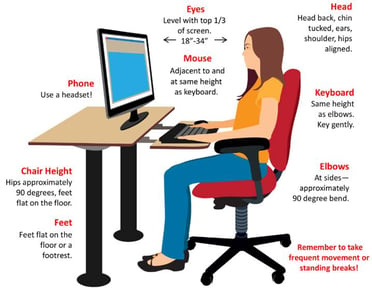Research suggests that more than 5% of the workforce is currently suffering from carpal tunnel syndrome. This musculoskeletal injury occurs when the median nerve that runs through the wrist is overused and becomes inflamed. Given the syndrome can impact any person, in any industry, many employers are putting practices in place to help reduce the risk of their employees developing the syndrome.
Body Position & Carpal Tunnel Prevention
One of the easiest ways to reduce the risk of carpal tunnel is to establish a neutral work space that keeps your body in the most natural position when seated. By finding a neutral position, you are able to lower the stress of static postures often associated with work. While creating a neutral work space is just a piece of the puzzle, implementing these simple steps will help keep your body aligned in a relaxed state to significantly reduce the risk of developing carpal tunnel.
How to Find a Neutral Seated Position
While the process of finding neutral when in a seated position is straight forward, there are several steps that should implemented to get into the optimal position when working.
- Step One: Keep your head directly above your shoulders
When in a seated position, you should have a straight back with your head positioned directly above your shoulders. The best way to get into this position is to imagine there is an invisible string connecting your ears to your shoulders, and then your shoulders to your hips. If that string is not vertical, you are not sitting in a neutral position.
- Step Two: Your feet must be flat on the floor
One of the biggest mistakes people make when in a sitting position is not supporting their feet. Ideally, your feet are flat on the floor in neutral position. This can usually be accomplished by simply lowering your chair. However, if your chair is not adjustable or you are unable to sit lower due to another medical condition, your feet should be supported with a foot rest.
- Step Three: Your hips should be level or slightly higher than your knees
It is important that your chair not be too low which can result in your knees being higher than your hips. In a neutral position, your knees and hips make a 90-100 degree angle with your torso.
- Step Four: Add a small gap between your knees and the front of your chair
When sitting in your chair, it is best to create a small space between the back of your knees and the front of your chair. This helps prevent you from slumping and ensures your body is best supported. The space should be 1 to 1.5 inches or 2-3 finger widths.
- Step Five: Create an “L” position with your elbows under your shoulders
This next step is often the most challenging to maintain when in a seated position. To properly find a neutral position, if your hands need to be on your desk, then there should be a 90 degree angle in your elbows with the top half of your arms directly under your shoulders. If your hands can be held by your side, then your entire arm should be straight under your shoulders. However, you want to avoid locking your elbows when holding them straight.
The idea is to maintain postures that require the least amount of effort on the body, so if you’re feeling tense thinking about how to get into these neutral positions, take a deep breath and relax the shoulders while the elbows and arms take on the “L” position. They will naturally relax with the shoulders with this oxygen intake.
6. Step Six: Hands/wrists are in a straight line with forearms
This last step involves maintaining the hands/wrists in a straight line with the forearms. This may require
an adjustment of either the chair height or the height of the surface your hands are required to work off.
When it comes to being in a neutral position when seated, it is important to remember that our body’s most comfortable position is to be in straight lines. While this may not feel natural to some of us in the beginning, keeping straight lines prevents stress on our muscles and nerves, significantly reducing the risk of developing carpal tunnel syndrome or any other musculoskeletal injury.
Learn More About On-going Training from Briotix
Briotix works diligently with our customers to reduce musculoskeletal injuries in employees of all positions. A major part of this work is on-going education from our professional Ergonomists. To learn more about how our team can help your company reduce workplace injuries and save you money, contact us today. Give us a call or complete the online form and we will contact you.
